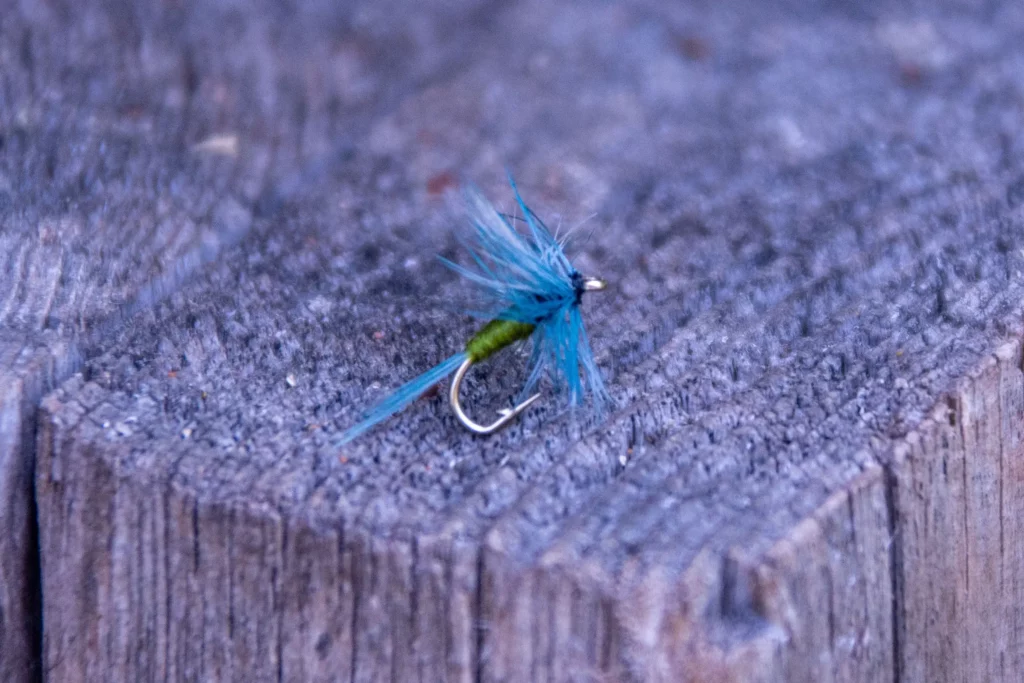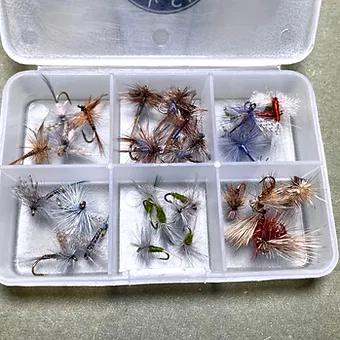The Art of Fishing Dry Flies in the Rain

As a fly fisherman, I’ve come to loathe those bright, sunny, cloudless days that everyone else seems to love. When people I encounter at the store start talking about how beautiful it is outside, all I can think is, “Yeah, but the fishing probably stinks!” Give me clouds! Give me rain!
In fact, when looking at the forecast to pick which days to fish, I often choose to go on the ones with a chance of rain. On wild trout streams, especially, hot and sunny can seriously hamper the bite, but good cloud cover will get fish up and feeding because it often gets insects more active in the stream. In fact, some of the heaviest mayfly hatches I’ve experienced have been immediately before, during, and after rainstorms. Notice I didn’t say thunderstorms! I don’t care how many trout are rising, it’s not worth fishing when there’s thunder and lightning on the horizon. But if it’s a nice soft rain or drizzle, count me in!
I know what you’re thinking. Keeping flies floating can be challenging enough on a dry day. How do you keep them floating in a downpour? Well, fishing in the rain isn’t all that different than any other time, but there are a few extra steps I take to make sure the fly stays floating longer. Successfully fishing and catching trout on dry flies in the rain usually comes down to using the right kind of floatant and flies to match the conditions.
Apply and Reapply Floatant
Dry fly floatant is an important part of the dry fly fishing process. To read about the various types of floatant and benefits of each brand, you might want to check out this article. For the purposes of fishing in the rain, I’m going to discuss only two general types of floatant and the value of each one.
First, before even making the first cast, I treat the dry fly with a liquid-type floatant or spray. I use a liberal amount and rub it into the fly. Most floatants are simply wax with some type of carrier agent. Upon application, the carrier agent typically evaporates, leaving your fly coated in a thin, protective layer. Repeated use and/or catches typically wash off this layer.
Ideally, I want this coating to dry, which allows the carrier agent to evaporate, before even starting to fish. I’ll often apply this floatant while still back at the truck as I’m getting ready to fish.
Once on the water, when my fly starts to sink a little more quickly than I like, I switch to a desiccant style of floatant. Desiccant floatant is a powder that draws the moisture from the fly. This type of floatant is typically either brushed on or comes in a small canister in which you place the fly to shake it up and coat the fly. Either type works great for reapplication. The most important part is that you really rub the desiccant into the fly to fully dry it.
Don’t worry about excess powder coating the fly. Most of this will come off when casting, but having an excess on there will also protect the fly for at least a short while. And the trout don’t seem to notice. I’ve never experienced any type of rejection from a trout because my fly was saturated with desiccant.
When the rain is really coming down, it’s not unusual to reapply floatant every 4-5 drifts. Also, after catching a fish, I rinse the fly thoroughly to get any slime off of it before applying new desiccant. Desiccant is an amazing product for drawing moisture out of the fly, but it’s basically worthless on slime.
Fish Larger Flies

I will often use a fly one size larger than whatever’s hatching when I’m dry fly fishing in the rain. Darker, overcast days often mean trout will be less selective (maybe because they can’t see the fly as clearly) than on sunny days. Add in a few raindrops breaking up the water’s surface and the size of the fly becomes even less important. This is incredibly helpful when using patterns that imitate small Baetis, which are hard to see at any time, let alone when there’s some rain or chop on the water. In nasty conditions, I’ll frequently use a fly at least one size larger and rarely notice any difference in how the trout take the fly. And if I do notice more refusals, I can eventually drop down a size.
During a rain is also a great time to pull out those flies with heavy hackle. Bushy patterns like the Humpy, for example, are great for prospecting small streams in the rain even when there’s no hatch taking place — not to mention these flies float like a cork.
Heavy hackle flies need not be just large flies. Even flies size 16 and smaller can be tied with an extra turn or two of dry fly hackle and stored in your fly box for a rainy day. The greater surface area of the extra hackle helps the fly float better in any kind of chop, including that caused by rain and wind.
Dry fly patterns that incorporate CDC in some way are a lot harder to keep floating in the rain. All it takes is for a raindrop or two to land squarely on the fly and it will sink. All this means is that you’ll need to reapply desiccant more often to keep them floating.
Have Lots of Extra Flies

After repeated catches, or even after prolonged fishing, sometimes a fly just gets so waterlogged that it’s easier to just change the fly than try to resuscitate it with floatant. Too many times, I think people make the mistake of false casting more to “dry the fly” between casts. But if the fly is sinking faster than you think it should, even after reapplying floatant, then maybe it’s just that the fly is too heavy from water and that’s what is pulling it under. For me, it’s a much quicker fix to simply tie on a fresh dry fly and start new.
This is also why I always advise carrying at least 3-4 of any pattern in your fly box — and actually more like 5-6. On any given outing, even in dry conditions, I account for snapping off one, losing one to a fish (such as getting so chewed up it simply won’t float anymore), or encountering a situation, such as a rainy day, where multiple fly changes can keep me fishing longer and more effectively. Having multiple copies of a pattern will allow you to make adjustments and changes as needed on the water without fear of running out just when the fishing is getting good.
Conclusion
Next time the forecast is calling for rain, take it as a sign that the trout in your local stream will be feeding. Not only that, but there’s a good chance you’ll encounter at least some kind of surface activity.
But even if you don’t hit a hatch, you can often have good action just prospecting a stream with a big dry fly. Having a plan that includes the right kind of floatant, flies specifically for these conditions, and extra flies as backups will put you on your way to successfully fishing and catching trout with dry flies in the rain.
Watch this Video to Learn More About Fishing Dry Flies in the Rain
Did You Find This Article Helpful?
Stay up to date with the Dark Skies Fly Fishing monthly newsletter for free and receive the latest posts in fly fishing news, tricks, tips, and techniques, stream reports, as well as updates on new flies added to the Online Store and exclusive discounts!
Sign Up NowHave a fly fishing question you’d like answered? Drop us a line at info@darkskskiesflyfishing.com! If we use your question in a blog post or in the newsletter, we’ll send you a FREE fly box with a dozen of our favorite nymphs and dry flies!

